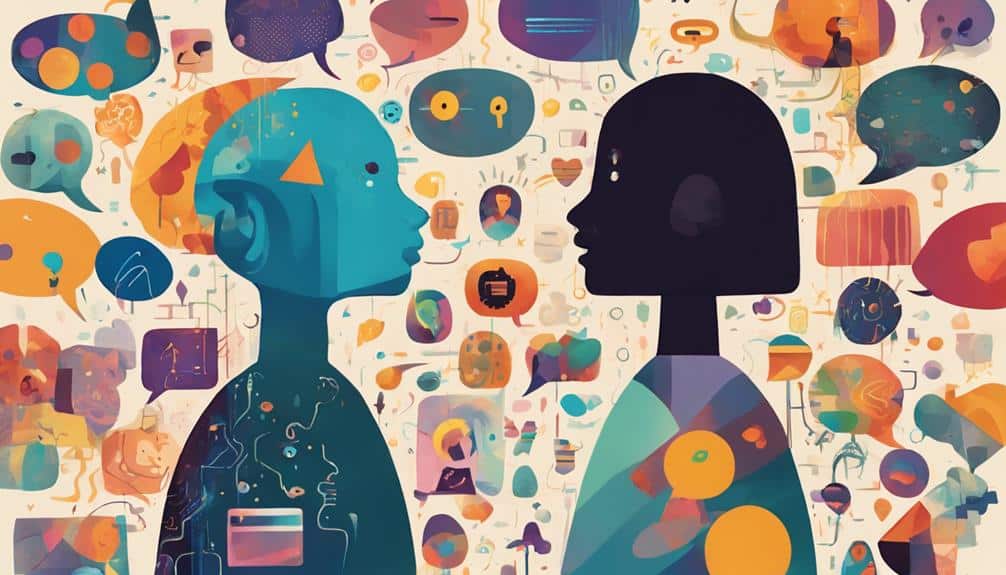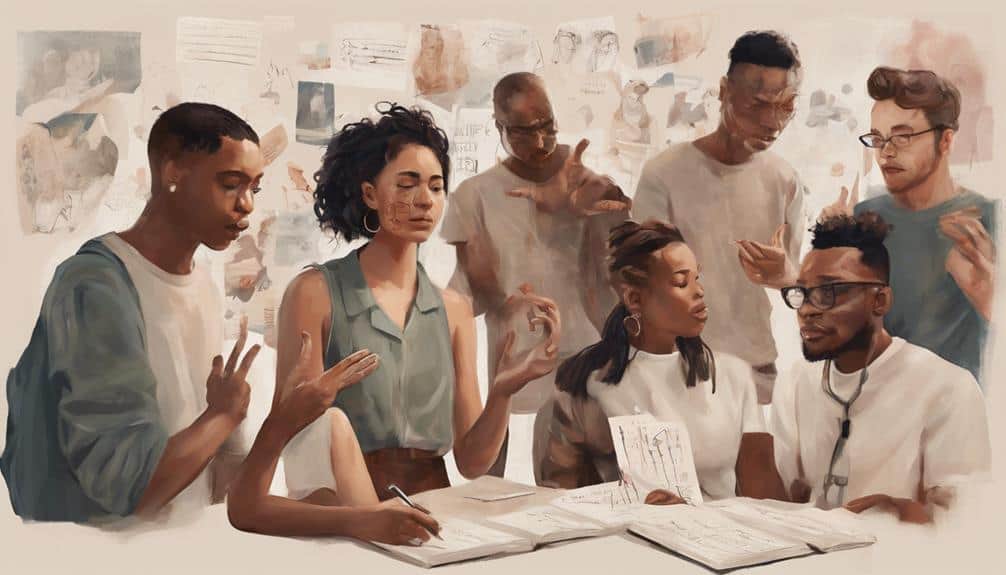Neurodivergent Communication
Exploring the landscape of neurodivergent communication is like deciphering a complex puzzle; each piece unique, requiring patience and understanding to reveal the complete picture.
As I unravel the intricacies of how different minds interact, I uncover the beauty in diverse perspectives and the power of effective communication strategies.
Join me as we explore the subtle nuances and impactful ways in which we can bridge the gap between neurotypical and neurodivergent individuals, forging connections that transcend barriers and enrich our interactions in ways we never imagined.
Key Takeaways
- Recognize diverse communication styles in neurodivergent individuals for inclusive interactions.
- Adapt communication approaches to accommodate varied preferences and enhance connections.
- Value direct communication, visual aids, and nonverbal cues for effective dialogue.
- Foster genuine connections through tailored communication, embracing diverse methods.
Understanding Neurodivergent Communication Styles

In steering neurodivergent communication styles, it's essential to recognize the diverse ways in which individuals with conditions like autism, ADHD, or dyslexia may prefer to interact. As an autistic individual myself, I understand the importance of acknowledging and embracing the unique communication styles that neurodivergent individuals exhibit. Some of us may prefer direct communication, while others might rely more on visual aids or nonverbal cues to convey our thoughts and feelings effectively.
For neurotypical individuals, understanding and adapting to these varied communication styles can foster better connections and interactions with neurodivergent individuals. By practicing inclusive communication techniques that cater to different preferences, we can create a more supportive and accommodating environment for everyone involved. It's vital to remember that what works for one person may not work for another, so remaining open-minded and flexible in our approach is key to promoting understanding and inclusivity in our interactions.
Ultimately, embracing the diversity of communication styles within the neurodivergent community enriches our relationships and enables us to communicate more effectively with one another.
Promoting Inclusivity Through Communication

Understanding and embracing the diverse communication styles within the neurodivergent community is essential for promoting inclusivity and fostering meaningful connections. People on the Autism Spectrum and other neurodivergent individuals often struggle with picking up on social cues or interpreting nonverbal communication. As a result, effective communication strategies need to be tailored to accommodate these differences. By acknowledging and respecting these unique communication styles, we can create an environment where all individuals feel valued and understood.
Experimenting with various communication approaches is key to finding methods that work best for different neurodivergent conditions. Implementing inclusive communication strategies not only helps neurodivergent individuals feel more comfortable and accepted but also benefits everyone involved by leading to more meaningful interactions and relationships. Taking the time to understand and adapt to diverse communication styles demonstrates a commitment to inclusivity and sets the stage for fostering genuine connections within the neurodivergent community.
Navigating Differences in Communication Methods

Exploring the diverse array of communication methods present in the neurodivergent community requires a keen awareness of individual preferences and styles. Autistic individuals may communicate through various means such as speech, AAC, symbols, body language, or electronic devices. Understanding these preferences is important as neurodivergent communication methods can encompass signing, Makaton, emojis, and written communication, differing greatly from neurotypical communication styles.
When interacting with autistic people, recognizing their preference for direct, clear communication is essential. They often favor straightforward language over vague or euphemistic expressions. Nonverbal communication also plays a significant role in neurodivergent communication, emphasizing the need to interpret gestures, facial expressions, and body language accurately.
To navigate these differences effectively, honing communication skills and customizing approaches based on individual needs are critical. Tailored approaches make sure that communication gaps are bridged successfully, fostering understanding and inclusivity within the neurodivergent community. By embracing diverse communication methods and respecting individual preferences, we can create spaces where everyone feels heard and valued.
Enhancing Relationships With Neurodivergent Communication

Connecting with relationships with neurodivergent individuals involves fostering connections through genuine conversations and shared interests rather than relying on superficial small talk.
For many autistic individuals, including myself, meaningful discussions hold more value than casual chit-chat. We often engage in info-dumping, sharing our passions and interests in detail to form connections based on genuine understanding.
Direct communication is key in these interactions; clarity is preferred over social niceties, allowing for open and honest conversations. Understanding body language differences is essential for effective communication.
Some neurodivergent individuals, like me, may have unique ways of expressing themselves through movement or gestures, which should be respected and acknowledged. Recognizing language processing disparities, such as the use of scripts or asynchronous communication, can help bridge communication gaps and foster deeper connections.
Fostering Connection Through Diverse Communication

Engaging with neurodivergent individuals involves embracing a variety of communication methods to foster genuine connections and understanding. For a neurodivergent person, communication goes beyond words; it encompasses AAC devices, body language differences, and unique language processing.
Meaningful discussions, focusing on shared interests rather than small talk, are key to building relationships with autistic individuals. Direct communication is valued by many on the spectrum for its clarity and lack of ambiguity. Body language differences, such as exaggerated gestures or intense eye contact, serve as important cues in communication for some autistic individuals. Understanding and respecting these differences can lead to more effective interactions.
Language processing in autism varies widely, from echolalia to self-generated language. Providing space for asynchronous communication allows time for processing, ensuring smoother exchanges. By recognizing and utilizing diverse communication methods, we can create an inclusive environment where all individuals feel heard and understood.
Frequently Asked Questions
Do Neurodivergent People Communicate Differently?
I notice some neurodivergent individuals communicate differently. They might rely more on nonverbal cues, have unique sensory processing, prefer clarity in social interactions, use distinct communication styles, and benefit from empathy and understanding of neurodiversity acceptance.
How Do You Communicate Effectively With Neurodivergent?
To communicate effectively with neurodivergent individuals, I prioritize understanding their unique needs and preferences. This involves being mindful of nonverbal cues, sensory sensitivity, social scripts, and providing clear instructions while showing empathy and engaging in direct communication.
What Are Signs of a Neurodivergent Person?
So, signs of a neurodivergent person may include challenges with nonverbal cues, sensory sensitivities, social interactions, unique communication styles, emotional expressions, and cognitive processing. Understanding these aspects can foster better connections and support.
How Do You Talk to Someone Who Is Neurodivergent?
When talking to someone who is neurodivergent, it's important to understand boundaries, build rapport, respect different perspectives, be mindful of nonverbal cues, practice active listening, and recognize varying social cues for effective communication.
Conclusion
To sum up, embracing neurodivergent communication styles is vital for creating inclusive and understanding environments.
While it may require some adjustment and learning on both sides, the benefits of promoting diverse communication methods far outweigh any initial challenges.
By recognizing and accommodating different communication needs, we can foster meaningful connections and relationships with neurodivergent individuals.
Let's work together to celebrate neurodiversity and create a more inclusive world for everyone.







